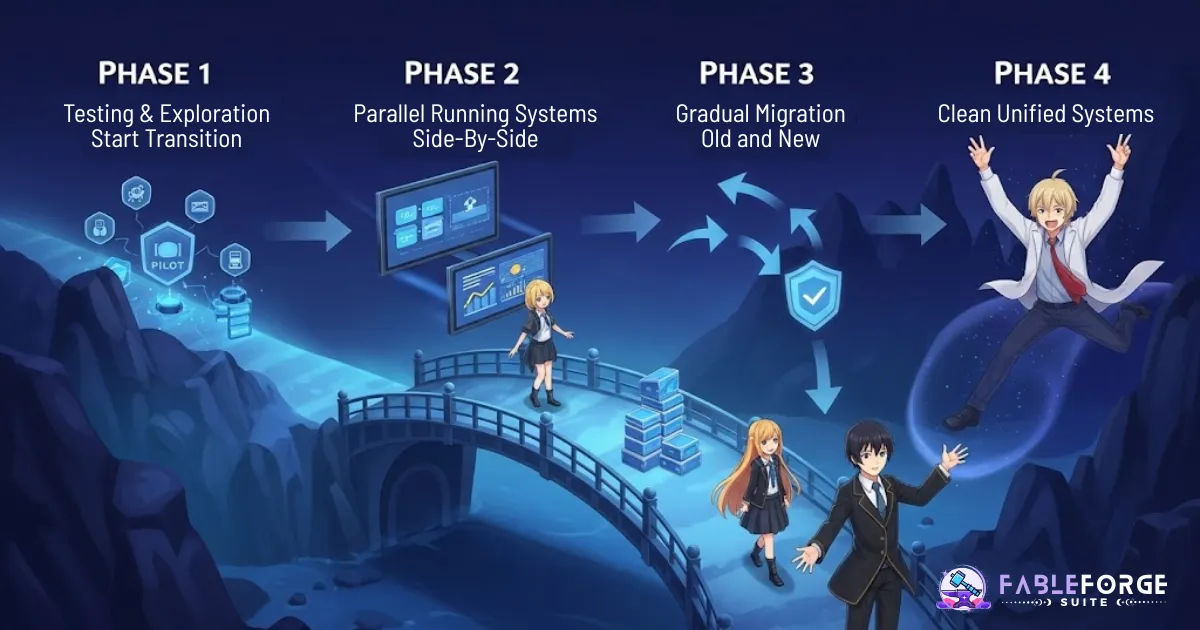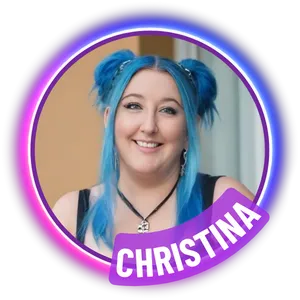
How to Change Your Business Systems Without Breaking Everything (4-Phase Framework)
You know your current setup is chaotic, but the thought of transitioning to something new feels overwhelming and risky. Here's how to make smart system changes without losing your data, disrupting your business, or having a breakdown in the process.
Here's the conversation I have with entrepreneurs constantly:
Them: "I know my systems are a mess, but I'm terrified to change anything."
Me: "What are you afraid of?"
Them: "Breaking everything. Losing data. Making it worse. Having my business fall apart during the transition."
I get it. When your income depends on your systems working, even the thought of changing them can feel paralyzing.
But here's the thing: staying stuck in chaos is also risky. While you're worried about the hypothetical problems of transitioning, you're experiencing the real problems of scattered systems every single day.
Today, let's talk about how to make changes safely.
The Transition Paralysis
Most entrepreneurs get stuck in one of these mental traps when they want to improve their systems:
🧠 Analysis Paralysis
"I need to research every option and find the perfect solution before I do anything."
The trap: You spend months researching and never actually make a decision.
😰 All-or-Nothing Thinking
"I have to migrate everything at once or it won't work."
The trap: The overwhelming scope prevents you from starting at all.
💸 Sunk Cost Spiral
"I've already paid for this year of [tool], so I should wait until it expires."
The trap: You keep paying monthly costs to avoid "wasting" the upfront payment.
🎯 Perfectionist Procrastination
"I need to plan every detail of the transition before I start."
The trap: Perfect planning becomes procrastination in disguise.
Result: Months (or years) of research and planning... with zero actual improvement.
The Smart Transition Framework
Instead of trying to overhaul everything at once, successful transitions happen in phases. Here's the exact framework that works:
Phase 1: Test Drive (Weeks 1-2)
Goal: Explore options without committing to anything
Pick ONE problem area from your audit (the most frustrating one)
Research 2-3 potential solutions (not 15 - just 2-3)
Sign up for free trials and actually test them with real scenarios
Keep your current system running while you test
Example: If email marketing is your biggest headache, test 2 different email platforms with a small segment of your list.
Phase 2: Pilot Program (Weeks 3-4)
Goal: Run new and old systems in parallel
Choose one solution based on your testing
Start using it for NEW stuff only (new subscribers, new content)
Keep existing stuff in the old system for now
Document what you like and don't like about the new approach
Example: Put new email subscribers in the new platform while existing subscribers stay in the old one. Create new content in the new system.
Phase 3: Gradual Migration (Weeks 5-8)
Goal: Slowly move existing stuff over
Pick the lowest-risk items to move first (old content, archived contacts)
Move one category at a time (this week: move email templates, next week: move automation sequences)
Test everything before disconnecting the old system
Keep backups of everything as you go
Example: Export your email list in segments of 500 people, import each segment to the new platform, test that automations work with each batch before moving the next one.
Phase 4: Full Transition (Week 9+)
Goal: Complete the switch and optimize
Move the last pieces once you're confident everything works
Cancel old subscriptions (finally!)
Optimize your new setup based on what you learned
Celebrate - you did something most people never do!
Example: Update all your opt-in forms to connect to the new platform, redirect any old links, cancel your old subscriptions, and set up analytics to track how the new system is performing.
Real-World Transition Examples
Let's see how this framework actually works in practice:
Emma's Email Platform Switch
Weeks 1-2 (Test Drive): Tested FableForge and ActiveCampaign with 50 subscribers each to see which felt easier to use and integrated better with her other needs
Weeks 3-4 (Pilot): Chose FableForge because it handled email + client management + payments in one place, started putting new subscribers there, moved her welcome sequence over
Weeks 5-6 (Gradual Migration): Exported main list in segments of 500, imported to FableForge, tested automations with each batch
Weeks 7-8 (Full Transition): Moved final automation sequences, updated all opt-in forms to point to FableForge, canceled Mailchimp subscription
Total business disruption: Zero. Her subscribers never noticed the switch, and she eliminated 3 other tools in the process.
David's Client Management Overhaul
Weeks 1-2 (Test Drive): Tested FableForge with 3 new prospects, compared to his spreadsheet + separate email + separate scheduling method
Weeks 3-4 (Pilot): Chose FableForge because it combined his CRM, scheduling, and email needs, created client onboarding process for 2 incoming clients only
Weeks 5-6 (Gradual Migration): Added existing clients' contact info during regular check-ins, moved session notes one client at a time
Weeks 7-8 (Full Transition): Imported remaining client data, set up automated follow-up reminders, canceled separate subscriptions for Calendly and his email platform
Result: Smoother client experience, less time hunting for information, automated follow-ups he used to forget, and eliminated 4 separate tools.
Common Transition Mistakes (And How to Avoid Them)
❌ Mistake: Trying to move everything at once
✅ Better: Move one piece at a time, test each step
Why this works: You can catch problems early and fix them before they affect everything.
❌ Mistake: Canceling old tools too quickly
✅ Better: Run parallel systems until you're confident
Why this works: You have a backup if something goes wrong, and you can verify everything transferred correctly.
❌ Mistake: Not backing up data before migrating
✅ Better: Export everything before you start, save copies locally
Why this works: Even if the new platform has import issues, you haven't lost anything permanently.
❌ Mistake: Choosing tools based on features alone
✅ Better: Test with your actual workflows and content
Why this works: Features that look good in demos might not work well with your specific use cases.
❌ Mistake: Planning for months without starting
✅ Better: Start with imperfect action, refine as you go
Why this works: You learn more from 2 weeks of testing than 2 months of researching.
When Perfectionism Tries to Sabotage Your Progress
Perfectionist brain says: "I need to find the absolute best solution."
Reality: There's no perfect tool. There are tools that work better for your specific situation.
Perfectionist brain says: "I should migrate everything perfectly in one go."
Reality: Messy progress beats perfect planning that never happens.
Perfectionist brain says: "What if I choose wrong and have to change again?"
Reality: You can change again. Business systems evolve. That's normal.
Perfectionist brain says: "I need to research every possible option."
Reality: Good enough is better than perfect, especially when perfect means staying stuck.
The Hidden Costs of Staying Stuck
While you're worried about the risks of changing, consider the costs of not changing:
Financial Costs:
Continuing to pay for tools that don't work well together
Lost opportunities from poor client experience
Time costs of managing complex systems
Opportunity Costs:
Energy spent on tool management instead of business growth
Client frustration leading to refunds or poor reviews
Mental overhead affecting your decision-making capacity
Growth Limitations:
Systems that can't scale with your business
Inability to add team members because processes are too complex
Competitive disadvantage from poor operational efficiency
The Risk-Mitigation Strategies
Start small: Test with non-critical parts of your business first.
Keep backups: Export all data before making any changes.
Run parallel systems: Don't burn bridges until you're confident.
Test thoroughly: Use real data and workflows, not just demo scenarios.
Have a rollback plan: Know how to reverse changes if needed.
Get help when needed: Some transitions are worth paying an expert to handle.
Your Transition Action Plan
Based on your current situation, here's how to move forward:
If you're ready to dive in:
This week:
Pick your biggest pain point from your system audit
Research 2-3 potential solutions
Sign up for free trials of the most promising options
Next week: Start testing with real scenarios (not just the demo data)
The week after: Make a decision and start your pilot program with new stuff only
If you need to think it through:
This week:
Re-read your system audit results
Talk to someone about what you discovered (partner, friend, business mentor)
Calculate the real cost of your current scattered setup (time + money + stress)
Next week: Decide if the cost of staying the same is higher than the effort of changing
If you want expert guidance:
This week:
Identify whether you need strategic advice, technical implementation, or both
Look for people who understand your business model (not just general "business consultants")
Ask specific questions about their approach to transitions and training
The Permission You Need
You don't have to get it perfect on the first try.
Every successful entrepreneur I know has changed systems multiple times as their business grew. The key is making progress, not making perfect decisions.
You're allowed to:
Start with an imperfect solution that's better than what you have
Change your mind if something isn't working
Take longer than planned if life gets chaotic
Ask for help during the transition
Test multiple options before committing
The Success Mindset
Think progress, not perfection: A good system you're actually using beats a perfect system you never implement.
Think evolution, not revolution: Small improvements compound over time.
Think testing, not committing: Free trials exist for a reason - use them.
Think parallel, not replacement: Run old and new systems together until you're confident.
Your Next Step
Pick one thing - just one - that you're going to test in the next 7 days based on what you've learned.
It could be:
Signing up for a free trial of one tool to replace your biggest frustration
Exporting your data as a backup (even if you don't migrate yet)
Setting up one automation to save you time each week
Having one conversation about getting help with your systems
Small progress beats perfect plans that never happen.
The Bottom Line
Most entrepreneurs stay stuck in chaotic systems not because change is actually risky, but because they're afraid it might be risky.
The reality: Smart, gradual transitions are much safer than continuing to operate with scattered, unreliable systems.
The secret: You don't have to see the whole staircase to take the first step.
Ready to start your transition? Get our free email course "Business Systems That Scale" for detailed guides on system auditing, safe migration strategies, and building systems that grow with your business.
Get the Free Course >> https://fableforgesuite.com/newsletter
Book a Curiosity Call >> https://fableforgesuite.com/call
Learn About FableForge >> https://fableforgesuite.com/what



